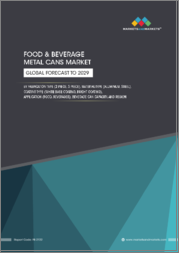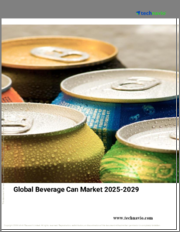
|
시장보고서
상품코드
1297849
세계의 음료 캔 시장(2023-2030년)Global Beverage Cans Market - 2023-2030 |
||||||
시장 개요
세계 음료 캔 시장은 2022년 350억 달러, 2030년에는 530억 달러에 달할 것으로 예상되며, 유리한 성장세를 보일 것으로 예상됩니다. 예측 기간 2023-2030년 CAGR은 5.2%로 예측됩니다.
음료 캔은 캔 인쇄, 장식, 브랜딩 강화 등의 기능을 갖춘 다용도 포장 솔루션입니다. 이지 오픈 엔드(EOE)는 소비자의 편의성을 높입니다. 이러한 요소들은 전체적으로 음료 캔 시장의 매력과 기능성에 기여합니다. 음료 캔 시장은 편의성과 휴대성에 대한 소비자 수요 증가로 인해 강력하게 성장하고 있습니다.
음료 캔 시장은 다양한 부문에서 캔 음료의 인기에 힘입어 크게 성장하고 있습니다. 캔 제조 기술의 발전과 이동 중에도 소비가 증가하는 추세는 음료 캔 시장의 지속적인 성장에 기여하고 있습니다. 소비자 취향의 변화와 지속가능한 포장 솔루션에 대한 요구가 맞물리면서 시장은 앞으로도 계속 상승세를 이어갈 것으로 예상됩니다.
시장 역학
환경의식과 지속가능한 포장으로 음료 캔 시장 성장 촉진
음료 캔 시장 분석에 따르면, 환경 인식과 지속가능성이 음료 캔 시장의 중요한 촉진요인으로 부상하고 있습니다. 음료용 알루미늄 캔은 재활용이 가능하고 재활용률이 높은 것으로 알려져 있으며, 이는 환경 친화적인 포장 옵션에 대한 소비자의 수요 증가에 부합하는 것으로 나타났습니다. 캔의 성형 및 성형, 캔 코팅 및 라이닝을 포함한 음료 캔의 제조 공정은 지속가능한 관행과 재료에 초점을 맞추고 있습니다.
이러한 노력은 제품의 무결성을 보장하는 동시에 환경에 미치는 영향을 최소화하는 것을 목표로 합니다. 알루미늄 캔의 경량 특성을 강조함으로써 운송 배출량과 에너지 소비를 더욱 줄일 수 있습니다. 음료 산업이 지속가능성을 우선시하는 가운데 친환경 알루미늄 음료 캔 시장은 지속적으로 성장하고 있습니다. 이에 따라 음료 캔의 시장 점유율도 확대되고 있습니다.
원재료 가격 변동과 다양한 음료 캔 사이즈가 음료 캔 시장을 억제하는 요인으로 작용
음료 캔 시장의 또 다른 억제요인은 원자재 비용, 특히 알루미늄의 가격 변동입니다. 음료 캔 시장 분석에 따르면 알루미늄 가격은 최근 몇 년 동안 큰 변동을 겪고 있으며, 2016년부터 2020년까지 연평균 약 15%의 가격 상승이 예상됩니다. 이러한 변동은 음료 캔의 제조 비용에 직접적인 영향을 미쳐 제조업체의 이윤율에 영향을 미칩니다. 그 결과 음료 캔의 시장 점유율이 영향을 받습니다.
또한, 다양한 크기의 음료 캔에 대한 수요는 캔의 충전 및 포장 공정을 더욱 복잡하게 만들고, 제조 요건과 비용도 다양하게 변화합니다. 이러한 문제를 완화하기 위해 업계 기업들은 원가절감 방안을 시행하고 공급망 전략을 최적화하여 원자재 가격 변동에 적응하고 다양한 시장 수요에 대응하기 위해 노력하고 있습니다.
COVID-19 영향 분석
COVID-19 분석에는 COVID 이전 시나리오, COVID 시나리오, COVID 이후 시나리오가 포함되며, 가격 역학(COVID 이전 시나리오와 비교한 팬데믹 중 및 팬데믹 이후 가격 변동 포함), 공급 및 수요 스펙트럼(거래 제한, 봉쇄 및 후속 문제로 인한 수요 및 공급 변화), 정부 노력(정부 기관의 시장, 부문 및 산업 활성화 노력), 제조업체의 전략적 노력(제조업체가 COVID 문제를 완화하기 위해 취한 조치) 등이 포함됩니다.
목차
제1장 조사 방법과 범위
제2장 정의와 개요
제3장 주요 요약
제4장 시장 역학
- 영향을 미치는 요인
- 성장 촉진요인
- 성장 억제요인
- 기회
- 영향 분석
제5장 업계 분석
- Porter's Five Forces 분석
- 공급망 분석
- 가격 분석
- 규제 분석
제6장 COVID-19 분석
제7장 구조별
- 2 피스
- 3 피스
제8장 금속별
- 알루미늄
- 강
제9장 캔 사이즈별
- 250ml
- 330ml
- 500ml
- 550ml
- 기타
제10장 용도별
- 주류
- 탄산음료
- 과일과 야채 주스
- 스포츠 및 에너지 드링크
- 기타
제11장 지역별
- 북미
- 미국
- 캐나다
- 멕시코
- 유럽
- 독일
- 영국
- 프랑스
- 이탈리아
- 스페인
- 기타 유럽
- 남미
- 브라질
- 아르헨티나
- 기타 남미
- 아시아태평양
- 중국
- 인도
- 일본
- 호주
- 기타 아시아태평양
- 중동 및 아프리카
제12장 경쟁 상황
- 경쟁 시나리오
- 시장 포지셔닝/점유율 분석
- 인수합병 분석
제13장 기업 개요
- Ardagh Group SA
- 기업 개요
- 그레이드 포트폴리오와 설명
- 재무 개요
- 주요 발전
- Ball Corporation
- Can-Pack SA
- Crown Holdings, Inc.
- Amcor Plc
- Toyo Seikan Group Holdings, Ltd.
- Showa Denko KK
- Nampak Bevcan Ltd
- Silgan Holdings Inc.
- CPMC Holdings Ltd.
제14장 부록
ksm 23.07.11Market Overview
The Global Beverage Cans Market reached US$ 35 billion in 2022 and is projected to witness lucrative growth by reaching up to US$ 53 billion by 2030. The market is expected to exhibit a CAGR of 5.2% during the forecast period 2023-2030.
Beverage cans are versatile packaging solutions with features like can printing and decoration and enhancing branding. Easy-open ends (EOEs) add convenience for consumers. These elements collectively contribute to the market's appeal and functionality of beverage cans. The beverage cans market has grown strongly due to increasing consumer demand for convenience and portability.
The market has expanded significantly, driven by the popularity of canned beverages across various segments. Factors such as advancements in can manufacturing technologies and the rising trend of on-the-go consumption have contributed to the sustained growth of the beverage cans market. The market is expected to continue its upward trajectory in the coming years, fueled by evolving consumer preferences and the need for sustainable packaging solutions.
Market Dynamics
Environmental Consciousness and Sustainable Packaging Propel Growth of Beverage Cans Market
The Beverage Cans Market analysis shows that environmental consciousness and sustainability have emerged as significant drivers of the beverage cans market. Aluminum beverage cans, known for their recyclability and high recycling rate, align with the growing consumer demand for eco-friendly packaging options. Beverage can manufacturing processes, including can forming and shaping and can coating and lining, focus on sustainable practices and materials.
These efforts aim to minimize environmental impact while ensuring product integrity. The emphasis on aluminum cans' lightweight properties further reduces transportation emissions and energy consumption. As the beverage industry prioritizes sustainability, the environmentally friendly aluminum beverage cans market continues to grow. As a result, the beverage cans market share is also increased.
Volatility in Raw Material Prices and Diverse Beverage Can Sizes Pose Restraints for the Beverage Cans Market
Another restraint in the Beverage Cans Market is the volatility in raw material costs, particularly aluminum. According to the beverage cans market analysis, the price of aluminum experienced significant fluctuations in recent years, with an average annual price increase of around 15% between 2016 and 2020. These fluctuations can directly impact the manufacturing costs of beverage cans, affecting profit margins for manufacturers. As a result, the Beverage Cans' Market share is impacted.
Additionally, the demand for different beverage can size dimensions further adds complexity to the can filling and packaging processes, with varying production requirements and costs. To mitigate these challenges, industry players implement cost-saving measures and optimize supply chain strategies to adapt to the volatility in raw material costs and meet diverse market demands.
COVID-19 Impact Analysis
The COVID-19 Analysis includes Pre-COVID Scenario, COVID Scenario and Post-COVID Scenario along with Pricing Dynamics (Including pricing change during and post-pandemic comparing it with pre-COVID scenarios), Demand-Supply Spectrum (Shift in demand and supply owing to trading restrictions, lockdown and subsequent issues), Government Initiatives (Initiatives to revive market, sector or Industry by Government Bodies) and Manufacturers Strategic Initiatives (What manufacturers did to mitigate the COVID issues will be covered here).
Segment Analysis
The Global Beverage Cans Market is segmented based on structure, metal, can size, application, and region.
330ml Can Emerge as the Preferred Choice in Beverage Cans Market, Driven by Versatility and Portability
The Beverage Cans Market is segmented by can size, including popular options such as 250ml, 330ml, 500ml, and 550ml, along with other sizes. The 330ml can have emerged as the most preferred choice due to its versatility and widespread acceptance. It caters to various beverages, balances portability and volume, and is compatible with vending machines and retail displays.
Additionally, the beverage cans market trend indicates a growing demand for smaller sizes, such as 250ml, driven by the increasing popularity of healthier and functional beverages. This trend reflects consumer preferences for portion control and convenience.
Geographical Analysis
Asia Pacific Emerges as a Powerhouse in the Beverage Cans Market with Rapid Growth and High Consumer Demand
The Global Beverage Cans Market is segmented by region into North America, South America, Europe, Asia-Pacific, and Middle-East & Africa.
The Asia Pacific Beverage Cans Market is experiencing significant growth, driven by several factors. According to the beverage cans market analysis, the region holds a substantial Global Beverage Cans Market share. The rising population, urbanization, and changing lifestyles have contributed to the increased consumption of packaged beverages in the Asia Pacific region. These all are propelling Beverage Cans' Market share. Furthermore, the convenience and portability offered by beverage cans have resonated with consumers in this market.
Studies indicate that approximately 70% of individuals in the Asia Pacific region regularly consume beverages from cans. The demand for beverage cans is particularly prominent in countries such as China, India, and Japan, which have witnessed rapid economic development and an expanding middle-class population. With a buoyant market trend and a significant consumer base, the Asia Pacific beverage cans market presents lucrative opportunities for manufacturers and suppliers in the region.
Competitive Landscape
The major global players include: Ardagh Group S.A, Ball Corporation, Can-Pack S.A., Crown Holdings, Inc., Amcor Plc, Toyo Seikan Group Holdings, Ltd., Showa Denko K.K, Nampak Bevcan Ltd, Silgan Holdings Inc., and CPMC Holdings Ltd.
Why Purchase the Report?
- To visualize the Global Beverage Cans Market segmentation based on Structure, Metal, Can Size, application, and region and understand key commercial assets and players.
- Identify commercial opportunities by analyzing trends and co-development.
- Excel data sheet with numerous beverage cans market-level data points with all segments.
- The PDF report includes a comprehensive analysis after exhaustive qualitative interviews and an in-depth study.
- Product mapping available as Excel consisting of key products of all the major players.
The Global Beverage Cans Market Report Would Provide Approximately 69 Tables, 67 Figures And 195 pages.
Target Audience 2023
- Manufacturers/ Buyers
- Industry Investors/Investment Bankers
- Research Professionals
- Emerging Companies
Table of Contents
1. Methodology and Scope
- 1.1. Research Methodology
- 1.2. Research Objective and Scope of the Report
2. Definition and Overview
3. Executive Summary
- 3.1. Snippet by Structure
- 3.2. Snippet by Metal
- 3.3. Snippet by Can Size
- 3.4. Snippet by Application
- 3.5. Snippet by Region
4. Dynamics
- 4.1. Impacting Factors
- 4.1.1. Drivers
- 4.1.2. Restraints
- 4.1.3. Opportunity
- 4.1.4. Impact Analysis
5. Industry Analysis
- 5.1. Porter's Five Force Analysis
- 5.2. Supply Chain Analysis
- 5.3. Pricing Analysis
- 5.4. Regulatory Analysis
6. COVID-19 Analysis
- 6.1. Analysis of COVID-19
- 6.1.1. Scenario Before COVID-19
- 6.1.2. Scenario During COVID-19
- 6.1.3. Post COVID-19 and Future Scenario
- 6.2. Pricing Dynamics Amid COVID-19
- 6.3. Demand-Supply Spectrum
- 6.4. Government Initiatives Related to the Market During Pandemic
- 6.5. Manufacturers Strategic Initiatives
- 6.6. Conclusion
7. By Structure
- 7.1. Introduction
- 7.1.1. Market Size Analysis and Y-o-Y Growth Analysis (%), By Structure
- 7.1.2. Market Attractiveness Index, By Structure
- 7.2. 2-Piece*
- 7.2.1. Introduction
- 7.2.2. Market Size Analysis and Y-o-Y Growth Analysis (%)
- 7.3. 3-Piece
8. By Metal
- 8.1. Introduction
- 8.1.1. Market Size Analysis and Y-o-Y Growth Analysis (%), By Metal
- 8.1.2. Market Attractiveness Index, By Metal
- 8.2. Aluminum*
- 8.2.1. Introduction
- 8.2.2. Market Size Analysis and Y-o-Y Growth Analysis (%)
- 8.3. Steel
9. By Can Size
- 9.1. Introduction
- 9.1.1. Market Size Analysis and Y-o-Y Growth Analysis (%), By Can Size
- 9.1.2. Market Attractiveness Index, By Can Size
- 9.2. 250ml*
- 9.2.1. Introduction
- 9.2.2. Market Size Analysis and Y-o-Y Growth Analysis (%)
- 9.3. 330ml
- 9.4. 500ml
- 9.5. 550ml
- 9.6. Others
10. By Application
- 10.1. Introduction
- 10.1.1. Market Size Analysis and Y-o-Y Growth Analysis (%), By Application
- 10.1.2. Market Attractiveness Index, By Application
- 10.2. Alcoholic Beverages*
- 10.2.1. Introduction
- 10.2.2. Market Size Analysis and Y-o-Y Growth Analysis (%)
- 10.3. Carbonated Soft Drinks
- 10.4. Fruit & Vegetable Juices
- 10.5. Sports & Energy Drinks
- 10.6. Others
11. By Region
- 11.1. Introduction
- 11.1.1. Market Size Analysis and Y-o-Y Growth Analysis (%), By Region
- 11.1.2. Market Attractiveness Index, By Region
- 11.2. North America*
- 11.2.1. Introduction
- 11.2.2. Key Region-Specific Dynamics
- 11.2.3. Market Size Analysis and Y-o-Y Growth Analysis (%), By Structure
- 11.2.4. Market Size Analysis and Y-o-Y Growth Analysis (%), By Metal
- 11.2.5. Market Size Analysis and Y-o-Y Growth Analysis (%), By Can Size
- 11.2.6. Market Size Analysis and Y-o-Y Growth Analysis (%), By Application
- 11.2.7. Market Size Analysis and Y-o-Y Growth Analysis (%), By Country
- 11.2.7.1. The U.S.
- 11.2.7.2. Canada
- 11.2.7.3. Mexico
- 11.3. Europe
- 11.3.1. Introduction
- 11.3.2. Key Region-Specific Dynamics
- 11.3.3. Market Size Analysis and Y-o-Y Growth Analysis (%), By Structure
- 11.3.4. Market Size Analysis and Y-o-Y Growth Analysis (%), By Metal
- 11.3.5. Market Size Analysis and Y-o-Y Growth Analysis (%), By Can Size
- 11.3.6. Market Size Analysis and Y-o-Y Growth Analysis (%), By Application
- 11.3.7. Market Size Analysis and Y-o-Y Growth Analysis (%), By Country
- 11.3.7.1. Germany
- 11.3.7.2. The U.K
- 11.3.7.3. France
- 11.3.7.4. Italy
- 11.3.7.5. Spain
- 11.3.7.6. Rest of Europe
- 11.4. South America
- 11.4.1. Introduction
- 11.4.2. Key Region-Specific Dynamics
- 11.4.3. Market Size Analysis and Y-o-Y Growth Analysis (%), By Structure
- 11.4.4. Market Size Analysis and Y-o-Y Growth Analysis (%), By Metal
- 11.4.5. Market Size Analysis and Y-o-Y Growth Analysis (%), By Can Size
- 11.4.6. Market Size Analysis and Y-o-Y Growth Analysis (%), By Application
- 11.4.7. Market Size Analysis and Y-o-Y Growth Analysis (%), By Country
- 11.4.7.1. Brazil
- 11.4.7.2. Argentina
- 11.4.7.3. Rest of South America
- 11.5. Asia-Pacific
- 11.5.1. Introduction
- 11.5.2. Key Region-Specific Dynamics
- 11.5.3. Market Size Analysis and Y-o-Y Growth Analysis (%), By Structure
- 11.5.4. Market Size Analysis and Y-o-Y Growth Analysis (%), By Metal
- 11.5.5. Market Size Analysis and Y-o-Y Growth Analysis (%), By Can Size
- 11.5.6. Market Size Analysis and Y-o-Y Growth Analysis (%), By Application
- 11.5.7. Market Size Analysis and Y-o-Y Growth Analysis (%), By Country
- 11.5.7.1. China
- 11.5.7.2. India
- 11.5.7.3. Japan
- 11.5.7.4. Australia
- 11.5.7.5. Rest of Asia-Pacific
- 11.6. Middle East and Africa
- 11.6.1. Introduction
- 11.6.2. Key Region-Specific Dynamics
- 11.6.3. Market Size Analysis and Y-o-Y Growth Analysis (%), By Structure
- 11.6.4. Market Size Analysis and Y-o-Y Growth Analysis (%), By Metal
- 11.6.5. Market Size Analysis and Y-o-Y Growth Analysis (%), By Can Size
- 11.6.6. Market Size Analysis and Y-o-Y Growth Analysis (%), By Application
12. Competitive Landscape
- 12.1. Competitive Scenario
- 12.2. Market Positioning/Share Analysis
- 12.3. Mergers and Acquisitions Analysis
13. Company Profiles
- 13.1. Ardagh Group S.A
- 13.1.1. Company Overview
- 13.1.2. Grade Portfolio and Description
- 13.1.3. Financial Overview
- 13.1.4. Key Developments
- 13.2. Ball Corporation
- 13.3. Can-Pack S.A.
- 13.4. Crown Holdings, Inc.
- 13.5. Amcor Plc
- 13.6. Toyo Seikan Group Holdings, Ltd.
- 13.7. Showa Denko K.K
- 13.8. Nampak Bevcan Ltd
- 13.9. Silgan Holdings Inc.
- 13.10. CPMC Holdings Ltd.
LIST NOT EXHAUSTIVE
14. Appendix
- 14.1. About Us and Services
- 14.2. Contact Us



















